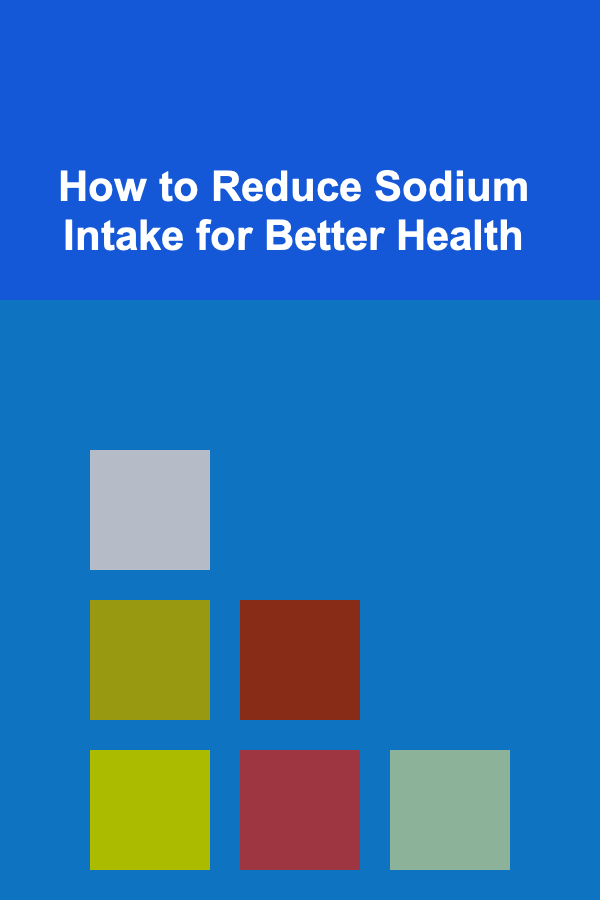
How to Reduce Sodium Intake for Better Health
ebook include PDF & Audio bundle (Micro Guide)
$12.99$10.99
Limited Time Offer! Order within the next:

Sodium, a mineral essential for maintaining fluid balance and normal cellular function, is an integral component of the human diet. However, excessive consumption of sodium, primarily in the form of salt (sodium chloride), can have detrimental effects on health, leading to conditions such as high blood pressure, cardiovascular diseases, kidney damage, and even strokes. This article explores the relationship between sodium intake and health, outlines the risks of excessive consumption, and provides practical strategies to reduce sodium intake for improved well-being.
Understanding Sodium and Its Role in the Body
Sodium is an electrolyte that helps regulate the body's fluid balance, nerve function, and muscle contractions. The body requires only a small amount of sodium to function properly. The average daily requirement for sodium is about 1,500 milligrams (mg) for most adults, with an upper limit of about 2,300 mg per day according to dietary guidelines set by health organizations like the American Heart Association (AHA) and the World Health Organization (WHO).
Despite its essential role, modern diets are often much higher in sodium than necessary, largely due to the widespread consumption of processed foods and restaurant meals that are packed with added salt. On average, adults consume about 3,400 mg of sodium per day, far exceeding the recommended intake. The excess sodium can lead to significant health issues over time.
The Health Risks of Excessive Sodium Intake
1. High Blood Pressure (Hypertension)
One of the most well-known effects of excessive sodium intake is high blood pressure. When you consume too much sodium, it causes the body to retain more water to balance the sodium concentration. This increase in fluid volume can lead to an increase in the overall blood volume, resulting in higher blood pressure. High blood pressure is a significant risk factor for heart disease, stroke, and kidney disease. In fact, reducing sodium intake is often one of the first recommendations for people with hypertension.
2. Cardiovascular Diseases
Excess sodium contributes to the development of cardiovascular diseases by raising blood pressure, which in turn strains the heart and blood vessels. Over time, elevated blood pressure can lead to heart attacks, heart failure, and other severe heart-related conditions. Studies have shown that reducing sodium intake can lower the risk of cardiovascular diseases significantly.
3. Kidney Damage
The kidneys are responsible for regulating sodium levels in the body. When sodium intake is too high, the kidneys have to work harder to remove the excess, which can lead to kidney dysfunction over time. High sodium intake can also contribute to the formation of kidney stones, further increasing the risk of kidney damage.
4. Stroke
High sodium intake has been linked to an increased risk of stroke. The relationship between sodium and stroke is primarily due to its effect on blood pressure. As mentioned, sodium can cause the blood pressure to rise, and over time, this can contribute to the development of blood clots or weaken blood vessels, both of which can increase the likelihood of a stroke.
5. Osteoporosis
Excessive sodium intake may also contribute to bone health issues, particularly osteoporosis. High sodium levels increase the excretion of calcium in the urine, which can lead to a decrease in bone density over time. This puts individuals at risk for fractures and weakened bones, particularly in older adults.
6. Obesity
Some studies suggest a connection between high sodium intake and obesity. Excessive sodium consumption can lead to an increase in thirst, which may cause individuals to drink sugary beverages, contributing to excess calorie intake. Furthermore, there is evidence suggesting that high sodium intake may interfere with the body's mechanisms for regulating fat storage and appetite.
Practical Tips for Reducing Sodium Intake
1. Read Food Labels Carefully
One of the most effective ways to reduce sodium intake is by being mindful of the sodium content in packaged foods. Food manufacturers are required to list the amount of sodium per serving on the nutrition label. Pay attention to both the serving size and the sodium content per serving. When possible, choose products labeled "low sodium," "no added salt," or "sodium-free." Keep in mind that some processed foods may still contain a significant amount of sodium, even if they don't taste salty.
2. Cook at Home and Control Your Ingredients
Home-cooked meals give you full control over the ingredients you use, allowing you to reduce or eliminate added salt. Instead of reaching for the salt shaker, consider using herbs, spices, lemon, garlic, and other flavorings to enhance the taste of your meals. These alternatives not only add variety to your food but also provide additional health benefits. Additionally, cooking from scratch allows you to avoid processed foods that are often high in sodium.
3. Limit Processed and Packaged Foods
Processed foods such as canned soups, frozen meals, fast food, and snacks are typically high in sodium. These foods often contain added preservatives, flavor enhancers, and excessive amounts of salt to extend shelf life and improve taste. To reduce sodium intake, try to limit your consumption of these foods and opt for fresh or minimally processed alternatives whenever possible.
4. Use Salt Substitutes Wisely
Salt substitutes that replace sodium with potassium chloride can be useful for those looking to reduce their sodium intake. However, these substitutes should be used with caution, particularly for individuals with kidney problems or those who take certain medications that affect potassium levels. Always consult with a healthcare provider before using salt substitutes regularly.
5. Choose Fresh or Frozen Vegetables
Fresh and frozen vegetables are naturally low in sodium, making them an excellent choice for a sodium-conscious diet. Canned vegetables, on the other hand, often contain added salt for preservation. If you do purchase canned vegetables, look for options labeled "no added salt" or rinse them thoroughly to remove some of the sodium.
6. Be Cautious When Eating Out
Eating out at restaurants or ordering takeout often leads to excessive sodium intake. Many restaurant dishes, especially fast food and prepared meals, are loaded with salt for flavor enhancement. When dining out, ask the restaurant to prepare your meal without added salt, and request sauces or dressings on the side. Opt for grilled, steamed, or baked options instead of fried or heavily seasoned dishes.
7. Use Lower-Sodium Condiments
Condiments such as soy sauce, ketchup, and salad dressings can be major sources of sodium. Opt for low-sodium versions of these condiments or use smaller amounts to cut back on salt. For example, you can use vinegar or lemon juice as a tangy alternative to dressings and sauces.
8. Increase Potassium-Rich Foods
Potassium helps balance the effects of sodium on blood pressure. By increasing your intake of potassium-rich foods, such as bananas, potatoes, tomatoes, spinach, and beans, you can help mitigate the negative effects of excess sodium. Aim for a diet that includes a variety of potassium-rich foods to support overall heart and kidney health.
9. Stay Hydrated
Drinking plenty of water throughout the day helps the body flush out excess sodium. Staying hydrated also supports kidney function, making it easier for your body to regulate sodium levels. Aim to drink at least eight 8-ounce glasses of water a day, or more if you are physically active or live in a hot climate.
10. Gradually Reduce Sodium Intake
If you are accustomed to eating foods high in sodium, it may take some time to adjust to lower sodium levels. Start by making small changes, such as cutting back on salt in your cooking or reducing the number of processed foods you eat. Over time, your taste buds will adapt, and you will begin to appreciate the natural flavors of food without the need for excessive salt.
The Importance of a Balanced Diet
While reducing sodium intake is crucial for good health, it is also important to focus on an overall balanced diet. Incorporating plenty of fruits, vegetables, whole grains, lean proteins, and healthy fats into your meals will provide essential nutrients that support heart health and overall well-being. A well-rounded diet, combined with regular physical activity, is the foundation of a healthy lifestyle.
Conclusion
Excessive sodium intake poses significant health risks, including high blood pressure, cardiovascular disease, kidney damage, and stroke. By making mindful choices, such as reading food labels, cooking at home, and reducing processed food consumption, individuals can effectively lower their sodium intake and improve their overall health. Reducing sodium is a gradual process that requires commitment, but the benefits---ranging from improved heart health to reduced risk of chronic disease---are well worth the effort. By adopting these strategies and maintaining a balanced diet, you can take proactive steps toward better health and a longer, more vibrant life.

How to Create a Conference Timeline: A Step-by-Step Checklist
Read More
How to Make the Most of Your Apartment's Limited Space
Read More
How to Make Your Home Feel Cozy with the Right Lighting
Read More
How to Soundproof Your Home on a Budget
Read More
How to Use Mirrors to Enhance and Organize Your Space
Read More
How To Find Entry-Level Jobs Without Experience
Read MoreOther Products

How to Create a Conference Timeline: A Step-by-Step Checklist
Read More
How to Make the Most of Your Apartment's Limited Space
Read More
How to Make Your Home Feel Cozy with the Right Lighting
Read More
How to Soundproof Your Home on a Budget
Read More
How to Use Mirrors to Enhance and Organize Your Space
Read More